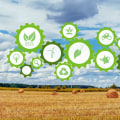The food and beverage industry is a highly competitive and ever-changing sector, with seasonality and freshness playing a major role in its success. Companies in this industry must be able to keep up with the demands of their customers, which can be difficult to do. QAD has developed a solution to help companies better manage their supply and demand needs. This industry includes fresh food, packaged foods, alcoholic beverages, and non-alcoholic beverages.
From supermarkets to restaurants, institutions, and events, the food and beverage industry serves a wide variety of outlets. It also requires specialized equipment to convert raw foods into food products on a large scale. Medicines may not be part of the food and beverage sector, but they do affect it due to their use for temperature-controlled transportation and storage. According to Geoff Freeman, president and CEO of the Consumer Brands Association, there is a good reason why food and beverage manufacturing construction is so popular right now.
The food and beverage industry includes all companies involved in transforming raw agricultural products into consumer food products. Fruits and vegetables are the most wasted foods, followed by dairy products and eggs. More than half of all waste is produced in homes and restaurants. Consumers are increasingly seeking out healthy and natural food options, which has led to growth in this category that exceeds conventional and specialty products.
The complexity of consumer choices and shopping habits has increased over the years as well. According to the Environmental Protection Agency (EPA), between 73 and 152 million metric tons of food are wasted each year in the United States. Finding and paying for labor is also a challenge for food and beverage companies, which is contributing to rising food prices. The containers used in this industry are designed to protect food from handling or contamination by biological, chemical, or physical sources.
Finding and paying for labor remains a challenge for food and beverage companies, which is contributing to rising food prices.









